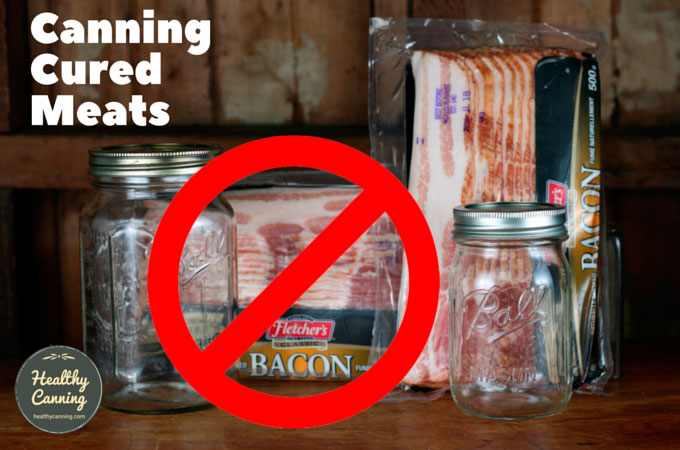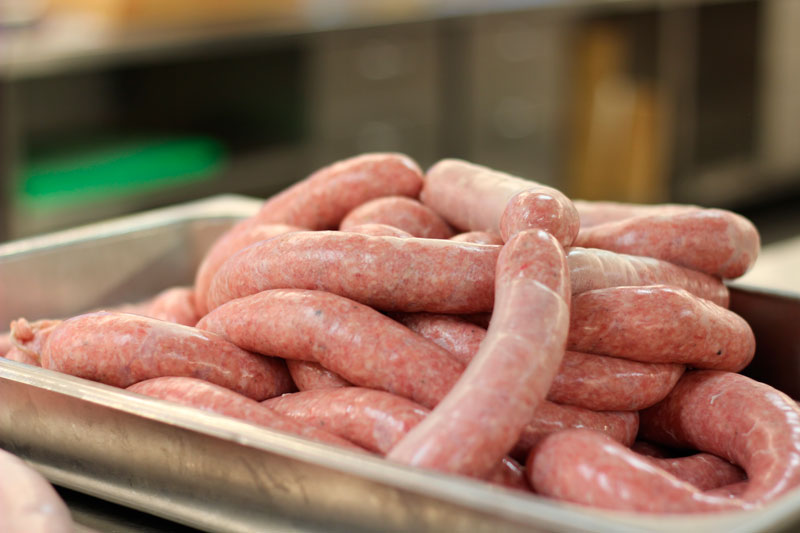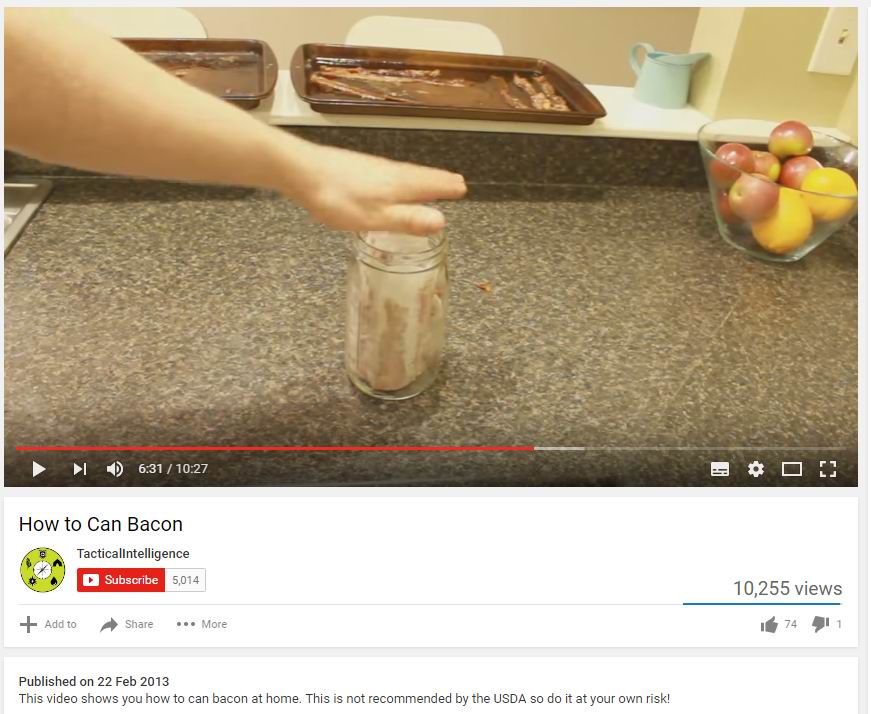Fair use.
WHAT DO THE HOME CANNING AUTHORITIES SAY ABOUT HOME CANNING CURED MEATS?
You can’t home can cured meats.
That’s the message being clearly sent out from The National Center for Home Food Preservation and university Extension Services.
The category of “cured meats” includes various forms of bacon, brined meats, corned meats, ham, etc, as well as any dried and / or air-cured meats.
The issue is that the curing changes the density of the meat, and that changed density was never tested for safety.
The National Center for Home Food Preservation (NCHFP) says, “We cannot support the canning of cured, brined or corned meats with the procedures for fresh meats. We can only recommend canning meats, poultry and seafood as described in the following recommendations, using the cuts and preparation steps included.” [1]
Note that the NCHFP is not trying to be mean or restrictive on purpose; they are being honest. They go on to say, “These are all the recommendations we have for meats, poultry and seafood.” [2] In other words, they have handed us all the research-based (and therefore guaranteed to-be-safe) home meat canning techniques that they have in their toolkit. They are not holding anything back.
The only tested, safe recommendations that are currently known to all reputable authorities are for fresh (as opposed to cured) meat home canning. These recommendations were researched and developed from the 1930s to the 1950s, which is the last time the US government decided to invest a small amount of money in home meat canning research (they were reviewed in the 1980s to ensure that they were still valid.) When someone asks them for a safe way to home can meat, those are the only pages they have to flip through to pull out that information for them.
Susan Barefoot of Clemson University explains further, “The USDA legacy work in canning of meats at home is what we have.” [3]
So why would cured meats be so different from the fresh meats that were studied? The texture of brined, corned or cured meat can often be different from that of “fresh” meat. For instance, it can be drier because moisture has been lost, which therefore makes it firmer and denser.
It’s entirely possible, therefore, that heat penetration would be slower, necessitating longer processing times. And the need for a different processing time is entirely possible — think about how fish turned out to be such a wildcard in pressure canning, pushing the processing times up to as much as 100 to 110 minutes and even requiring as well a special longer venting time before starting. Most YouTube video people probably would have “guessed”, wrongly, that using current meat processing times of 75 to 90 for fish would likely be too long because fish is more ‘delicate’. It took controlled research (done with a small amount of funding given to food science researchers in Alaska and Oregon) to bring to light the real processing requirements for
home canning fish and seafood.
On the other hand, owing to preservatives such as nitrites and nitrates in some but not all cured meat, it could be that processing time should be shorter for a subset of cured meats — and if that were the case, using current meat processing times would cause the meat to be over-processed, and lower-quality, and the NCHFP would get
flooded with complaints about that.
So besides the terrible liability if they were wrong, there’s just no upside to their guessing.
So to recap, all they have to go on are the legacy studies that were done in the 1930s to 1950s for canning of fresh meat. That small investment made in knowledge development and transfer has paid off a zillion times over since then — would that all government spending did — but since then, no further money has been invested in the subject of home canning any further meats.
It’s not that the home canning authorities are opposed to the idea of doing research on home canning cured meats. They would probably love to do it, if someone let them have the resources to do the project. In fact, their language may be code trying to signal that they’d love the go-ahead to do this:
“I think someone would have to come up with a worst-case scenario for heat penetration in all the possible variations and then do the testing.” [4]
If you want the NCFHP or one of the USDA university extensions to develop recommendations for home canning of cured meats, contact your elected representatives and ask for them to be allocated a bit of funding to do it. After all, the government’s never
not going to spend money: they mind as well direct a teeny bit to something that pays proven dividends for decades later.
Note : This also means no ham in your “
Your choice” USDA soup recipes, and no bacon tossed into your home canned baked beans. The exception is if you are using tested recipes such as the ones mentioned below that allow for it.
EXCEPTIONS
People hate this part — they’d prefer everything be black and white, but life isn’t like that.
The exception to the above rule about no cured meats is IF a research-based recipe has been developed and tested incorporating them, proving the use safe in that recipe.
- Split Pea Soup with Ham. (Appears in Ball Blue Book, 2014, 37th edition, page 107, and in Bernardin Guide, 2013 as Habitant Soup, page 94.)
- Salt Pork is used in two Bernardin Guide recipes, Bean Soup (page 95), and Baked Beans with Pork, (page 97.)
- Bacon or Ham can be added to to one “So Easy to Preserve” recipe: “Fill hot jars ¾ full with hot beans. Add one ¾ inch cube of pork, ham or bacon to each jar, if desired. Do not add any more meat or bacon.” [5]
- Safe processing times for smoked fish (note: fish only) have been determined through research and are available. The results are available on the NCHFP site.
SAUSAGE
You can can fresh sausage. lehtta1 / Pixabay.com / 2013 /
CC0 1.0
To be clear, you can can
fresh sausage, just not
dried or
cured sausage. You can also use fresh sausage meat to make sausage patties and can those. You can use fresh meat to make meatballs, and can those.
Just nothing from meat that has been cured, or salted or dried in anyway.
Here is the USDA procedure for
home canning fresh sausage (both Ball and Bernardin use the same USDA procedure.)
BACON: NO, YOU CAN’T HOME CAN BACON
Some of the bacon canning advice out there. Notice they even say “you’re on your own, Jack.”
Bacon counts as a cured meat; you cannot home can bacon. Anyone who says you can is just guessing and if the day comes when they are revealed as wrong, someone else will suffer for that guess.
Here’s a question and answer on the topic from Utah State University:
QUESTION: I am not sure who to direct this question to, maybe you can forward it to the person who can give me the answer. A lot is going around right now about canning bacon by rolling raw or cooked bacon in parchment paper (I think that is what it is called) putting it in quart jars with no liquid and pressure canning it at 15 lbs for 90 min. Is this safe to do and store in a cold storage room for am extended period of time? Thank you for your time. Susan
ANSWER: This practice is NOT recommended . The possible reasoning behind this advice is that bacon has nitrites in it that prevent the growth of C. botulinum (the botulism microorganism). Therefore “canning it” would somehow preserve it and make it safe to eat. However, there are many holes in that reasoning. 1. The advice is NOT research based. No one has actually studied the process to determine if indeed it is safe from foodborne illness. 2. There is no mention of “bacon” with nitrites (cured bacon). If people think its safe, they may try other processed meats. None have been research tested and all may result in botulism . 3. Canning something “dry” will NOT generate enough heat to make things safe. Heat is transferred by water. In a pressure canner steam heats the water inside a canned food transferring that heat to the food. A temperature of 240-250 F for 30-120 minutes is needed to make a pressure canned food safe (via a research-tested process). Without water the temperature the bacon reaches will not be enough to destroy the botulism organism!” [6]
So note that not only is canning bacon
not recommended, as in “they’re not sure so they don’t have an opinion”, it’s actually
actively recommended against.
References
| 1. | ↑ | National Center for Home Food Preservation. Preparing and Canning Poultry, Red Meats and Seafoods. Accessed June 2016. |
| 2. | ↑ | National Center for Home Food Preservation. Preparing and Canning Poultry, Red Meats and Seafoods. Accessed June 2016. |
| 3. | ↑ | Barefoot, Susan. There is no safe approved process for home canning cured, brined or corned meats. Clemson University Extension, Canning Tip # 55. Accessed June 2016. |
| 4. | ↑ | Barefoot, Susan. There is no safe approved process for home canning cured, brined or corned meats. Clemson University Extension, Canning Tip # 55. Accessed June 2016. |
| 5. | ↑ | Beans — Dry with Tomato or Molasses Sauce. In: Andress, Elizabeth L. and Judy A. Harrison. So Easy to Preserve. University of Georgia Cooperative Extension. Bulletin 989. Sixth Edition. 2014. Page 86. Also found in USDA Complete 2015, page 4-6. |
| 6. | ↑ | Dr. Brian Nummer, PhD. USU Extension Food Safety Specialist, 30 September 2015. Utah State University Forums ( https://usuext.vbulletin.net/forum/main-forum/75-adding-spices-to-research-tested-recipes) . Accessed June 2016. |
Link to source:
Home canning authorities say not to home can cured meats. The issue is that curing changes the density of the meat, and that that changed density has not been tested for safety.

www.healthycanning.com






